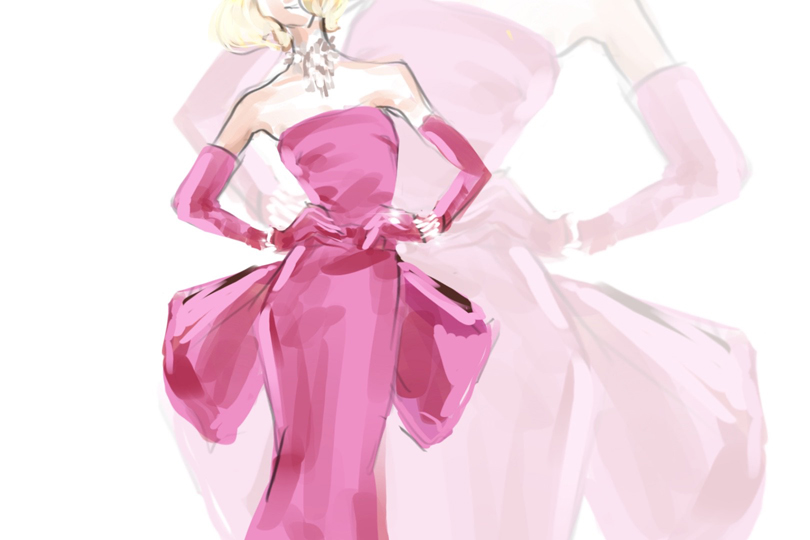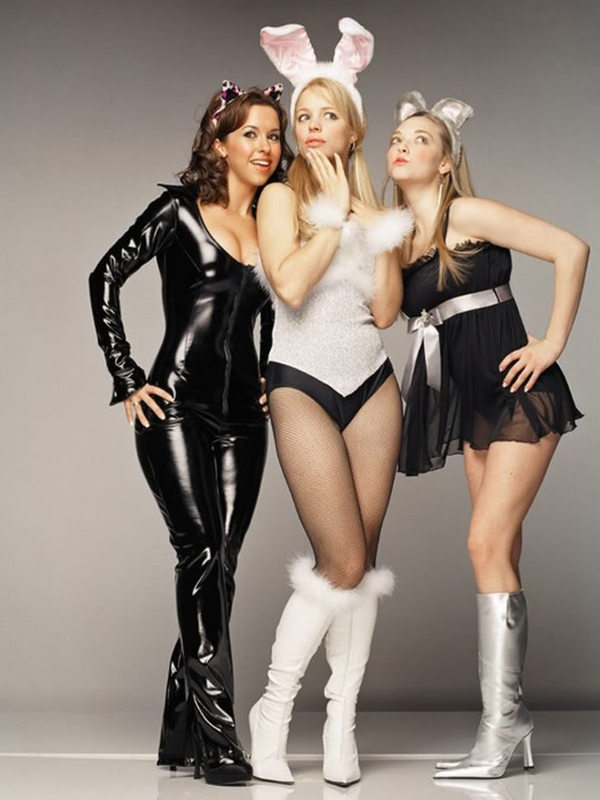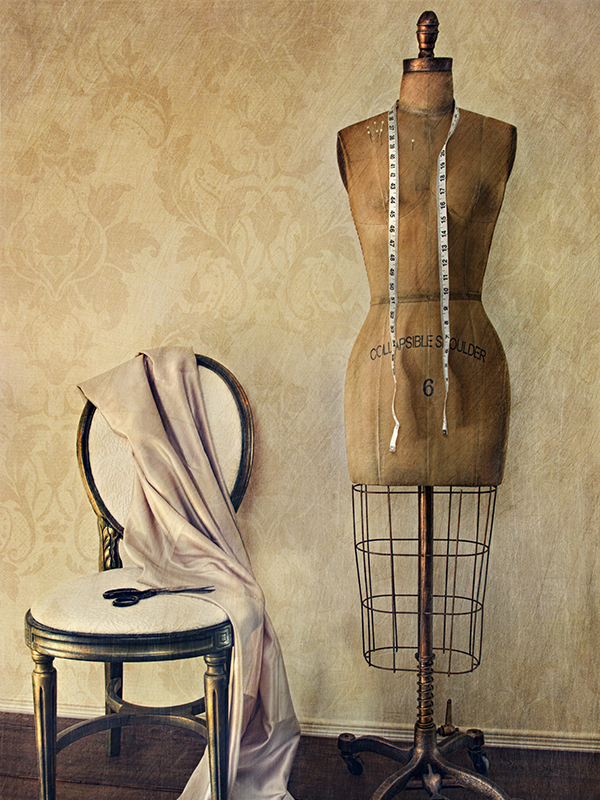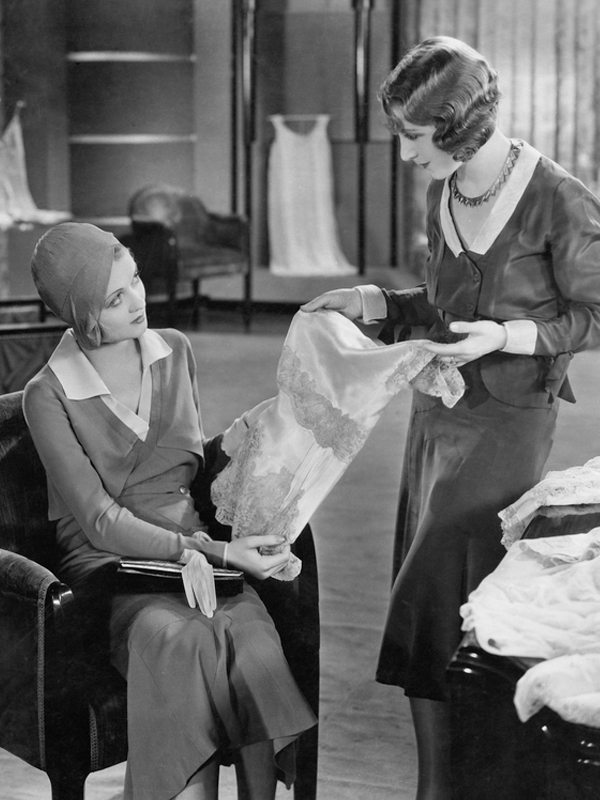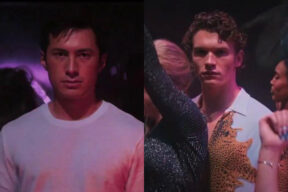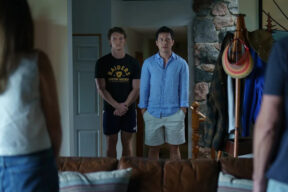Part of an ongoing series of 29Secrets stories, taking a deep dive into the history of legendary beauty products and iconic fashion and pop culture moments…
By Christopher Turner
Illustration by Michael Hak
In 1953, the world got its first glimpse at what would become a famous outfit, when Marilyn Monroe donned a floor-length hot pink column dress in the pivotal music sequence in the film Gentlemen Prefer Blondes, directed by Howard Hawks. The iconic pink silk dress was worn at a key point in Monroe’s career, and it has become practically synonymous with the legendary actress. Then, three decades after that debut, another famous blonde wore a replica of the pink gown as a tribute to her idol. One of Madonna’s most iconic looks from her career is also a floor-length hot pink dress, which she wore at a key point in her career, in the music video for her 1985 hit “Material Girl.”
Today the pink dress is one of the most recognizable dresses in fashion and pop culture history.… But you may be unfamiliar with its creator, costume designer William Travilla. You also may not know that the pink dress was actually a last-minute replacement intended to distance Monroe from one of the biggest scandals of her career. Here’s the fascinating true story of Marilyn Monroe’s pink Travilla dress that she wore to sing “Diamonds Are A Girl’s Best Friend” in Gentlemen Prefer Blondes, and Madonna’s pink “Material Girl” replica that she wore 32 years after the film.
The set-up
William “Billy” Travilla, professionally known as Travilla (pronounced Tra-via) was an American costume designer known for his work in theatre, film and television. Born on March 22, 1920, in Los Angeles, Travilla became interested in fashion at a young age and as an adolescent enrolled at the Chouinard Art Institute in Los Angeles. By the time he was 16, Travilla began to frequent burlesque clubs and started selling pencil sketches of his costume designs and ideas to the showgirls.
He started his career as a ghost-sketcher for studio costume designers at the long-standing Western Costume, one of the oldest costume warehouses in Hollywood. After years of working on B-movies, Travilla earned an Oscar in 1949 for Best Costume Design for the Errol Flynn swashbuckler Adventures of Don Juan.
The year after his Oscar win, Travilla became a contract designer at Twentieth Century Fox, which meant he would begin designing costumes for his long-time friend, an up-and-coming actress named Marilyn Monroe. Their first on-screen collaboration came when Travilla created the costumes for Roy Ward Baker’s Don’t Bother to Knock (1952), which was followed by Travilla creating costumes for another Monroe film, Howard Hawks’ Monkey Business (1952). Travilla once called a tan jersey dress he designed for Monroe to wear in a Monkey Business skating scene “the only costume of mine that Marilyn ever hated,” precisely because its full pleated skirt concealed, rather than showcased, her body. Monroe at first refused to wear the dress, until director Howard Hawks insisted.
Their third collaboration as artist and muse, on Gentlemen Prefer Blondes (1953), would catapult Monroe to name-above-the-title status, and eventually led to the most famous pink dress in cinematic history. By the time production began on this new Hawks musical, Travilla already intimately knew what worked best on the actress. And Monroe agreed.… She was once quoted as saying: “Billy Dear, please dress me forever. I love you, Marilyn.”
In Gentlemen Prefer Blondes, Monroe and co-star Jane Russell play a pair of showgirls on a transatlantic voyage to Paris who are followed by admirers and a few detectives. (Interestingly, according to Monroe’s last interview before her death, Russell, a brunette, received $200,000 for the film, while Monroe was paid her then usual $500-per-week salary.)
The job was perfect for Travilla, considering that much of his youth had been spent around showgirls. One of the key designs for Gentlemen Prefer Blondes was to be used in a musical number where Monroe’s Lorelei Lee performed “Diamonds Are a Girl’s Best Friend,” written by Jule Styne and Leo Robin. In a televised interview that aired decades after the film’s release, Travilla reminisced about what was demanded for the scene: “The idea then was that the studio make her the sexiest, most exciting, almost-naked lady on the screen.”
Travilla’s original design for the scene consisted of little more than a little nude fabric and a fishnet body stocking, which was pulled up to the breasts (with glistening jewels strategically placed in all the right spots), as well as long black gloves and a ton of rhinestone bracelets. It was sensational: in fact, the jaw-dropping showgirl costume cost close to $4,000 in 1953. The studio loved it, and Monroe did several wardrobe tests in the completed look. The scene was all set for filming – and then all hell broke loose.
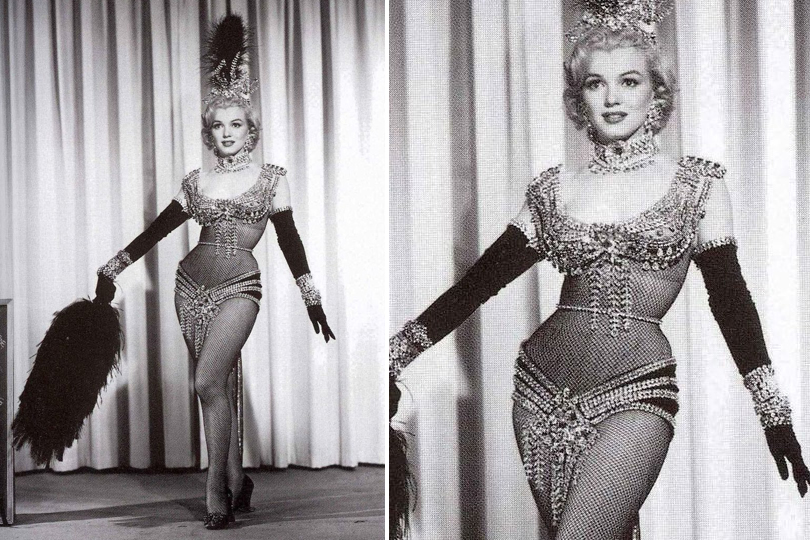
The scandal
In March 1952, with Gentlemen Prefer Blondes in early production, United Press wire-service reporter Aline Mosby uncovered the news that Monroe had posed for nude photographs back in 1949, and by 1952, at least one of those images was included in a calendar that could be found in barber shops, garages and hardware stores all around the US. (One of the images from that same photo shoot would famously be featured inside the first-ever issue of Playboy magazine in December 1953.)
Monroe found herself at the centre of a scandal, and Darryl F. Zanuck, then the studio head at Twentieth Century Fox, urged her to deny the story. Though Monroe has historically been reduced to a “dumb blonde” stereotype, she was anything but. In this and other instances throughout her career, she proved to be exceedingly savvy in handling herself and her own PR. Monroe ignored the studio’s advice and instead agreed to an exclusive interview with Mosby, in which she explained that she had agreed to pose for those 1949 photos, taken by Hollywood-based photographer Tom Kelley, for one simple reason: poverty.
“I was broke and needed the money. Why deny it?” she said in the interview. “Besides, I’m not ashamed of it, I’ve done nothing wrong.… Tom didn’t think anyone would recognize me. My hair was long then. But when the picture came out, everybody knew me.… I’d never have done it if I’d known things would happen so fast in Hollywood for me.”
Monroe did alter one aspect of her story. Some accounts explain that she needed the money – she was paid $50 for the two-hour photography session – to make a car payment, but in that interview, she said she needed it for rent, an explanation that she no doubt realized would garner her more sympathy.
Monroe’s strategy to defy the studio’s advice worked, gaining her public sympathy and increasing interest in her films. As public perception changed, Monroe’s status in Hollywood as a household name skyrocketed, and the public flocked to theatres to see Fritz Lang’s Clash by Night (1952) in order to get a glimpse at the girl making all the headlines, who had a supporting role in the film.
Despite Monroe’s newfound popularity, Travilla was given an emergency mandate by Zanuck. The studio didn’t want to run the risk of Monroe’s nude pictures popping up in connection to their next big release. “The studio went wild, and then I got a call: ‘Throw the [body stocking] costume out, we’ve got to dress her, we might lose all the box office for the film,’” he remembered. “So I made a very covered dress, a very famous pink dress with a big bow in back.”
With just two days until filming was due to begin on the “Diamonds Are A Girl’s Best Friend” scene, Travilla fashioned candy-pink peau d’ange (translated as “angel skin,” this fabric finish gives a soft, waxy surface look) silk against a backing of billiard felt to give the fabric some shape. From that, he created the floor-length strapless gown using just two side seams. “The dress was folded into shape, rather like cardboard,” Travilla explained years later. “Any other girl would have looked like she was wearing cardboard, but on the screen I swear you would have thought Marilyn had on a pale, thin piece of silk. Her body was so fabulous, it still came through!”
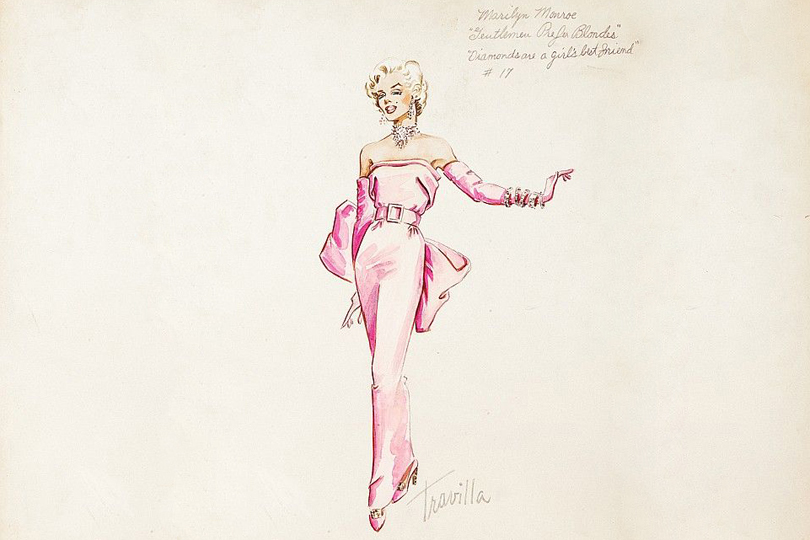
The dress featured a straight neckline and a large asymmetrical bow on the back, which was part of the dress construction, not added on as a separate piece. The bow was also lined with black satin and pleated in back on one side of the gown, then folded over and attached to the other section. The scene that features the dress was heavily choreographed, so a slit in the back of the dress was added to allow for movement, while a matching pink belt at the waist “crunched the whole thing in,” according to Travilla.
An early sketch of the pink gown shows it paired with long black opera gloves and black shoes – by Salvatore Ferragamo, Monroe’s preferred shoe designer – but in a final costume change, Travilla swapped out the black gloves for a pair of matching pink opera gloves. Of course, a heap of costume jewels on Monroe’s neck and wrists finished the look; while Hollywood lore over the years has insinuated that luxury jeweller Harry Winston provided genuine diamonds for the scene, Joan Joseff of Joseff of Hollywood is actually credited with crafting the film’s jewels.
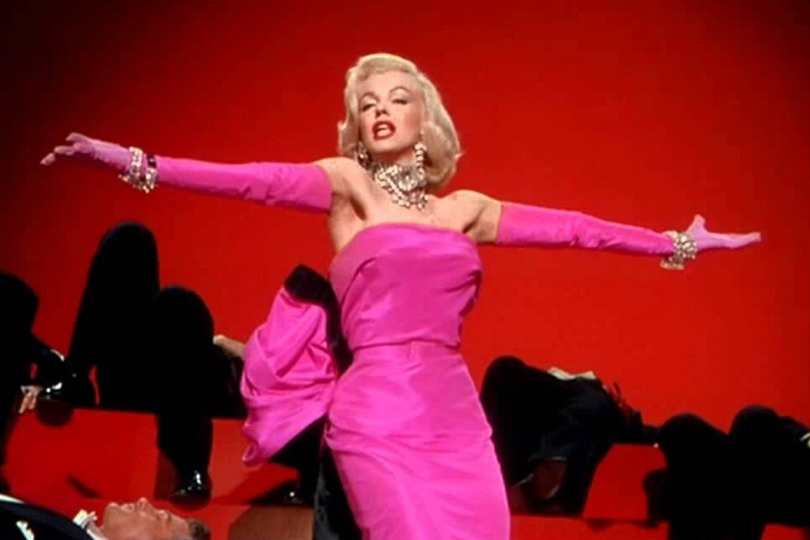
A second dress
Travilla died on November 2, 1990, after years spent collaborating with Monroe and other actresses in Hollywood. The notes he left behind revealed that there were two identical copies of the pink column dress that Monroe wore during the shooting of the scene. That’s likely because it took a long time to shoot the scene, and the dress, being floor length, was prone to getting dirt on it that the cameras would pick up.
However, only one pink dress is known to have survived the years; there is no record of what happened to the duplicate. The remaining pink dress was put up for auction at Profiles in History on June 11, 2010, with an estimated price of between $150,000 and $250,000, and was described as “the most important film costume to ever come to auction.” The dress was described in the auction catalogue as follows:
“This Travilla-designed pink silk satin strapless gown features black satin lining on the oversized bow attached at back. Features integral brassier [sic] with rear zipper closure (concealed with bow overlay) and interior Fox cleaning tag. Also comes with the original pair of screen-worn opera-length tubes worn over Marilyn’s arms (gloves are shown for display only) and pink satin belt with ‘M. Monroe A-698 1-27-3-7953’ written on the inner leather lining. Originally designed to be a two-piece garment, this lot features an additional bonus having the original top made for this dress (featuring interior bias label handwritten ‘1-27-3-7971 M. Monroe A 698-74’) that was not used in the production. This design was discarded due to the top and skirt separating when Marilyn raised her arms during the number. The gown exhibits slight toning in areas, common in silk garments from this era; otherwise in fine condition. The leather backing on the belt is cracked and missing in areas and silk exhibits fraying on edges.”
The dress ultimately sold for an impressive $370,000.
Material Girl
There’s no doubt about it.… Monroe’s rendition of the song “Diamonds Are a Girl’s Best Friend” and the pink Travilla dress that she wore in the scene are considered iconic, inspiring countless homages throughout the years from, among others, Kylie Jenner, Arianna Grande, Kylie Minogue and Anna Nicole Smith (not to mention Miss Piggy!). Of course, no homage has been cemented more in pop culture history than Madonna’s music video for “Material Girl.”
“Material Girl” was released to radio stations on November 30, 1984, by the Sire record label as the second single from Madonna’s Like a Virgin album. The song was an immediate commercial success, and Mary Lambert – who had worked with Madonna on the videos for “Like a Virgin” and “Borderline” – was hired to direct a video after Jean-Paul Goude fell through. The video, which was shot at the Ren-Mar Studios in Hollywood on January 10 and 11, 1985, was inspired by Madonna’s admiration of Monroe, and the video (and Madonna) intentionally mimicked the latter’s performance of “Diamonds Are a Girl’s Best Friend” from Gentlemen Prefer Blondes. In a 1987 interview with New York Daily News, Madonna said:
“Well, my favorite scene in all of Monroe’s movies is when she does that dance sequence for ‘Diamonds Are a Girl’s Best Friend.’ And when it came time to do the video for the song [‘Material Girl’], I said, ‘I can just redo that whole scene and it will be perfect.’ […] Marilyn was made into something not human in a way, and I can relate to that. Her sexuality was something everyone was obsessed with, and that I can relate to. And there were certain things about her vulnerability that I’m curious about and attracted to.”
In the video, a Howard Hughes-type character (played by actor Keith Carradine) obsesses over how to win the Madonna character’s heart. The storyline is intercut with splashy nearly shot-by-shot sequences of Madonna reinventing the famous Monroe scene, which were choreographed for Madonna and a crew of tuxedo-clad chorus boys by Kenny Ortega.
The setting for the sequences was also meticulously replicated from the film. The red background and red staircase were reconstructed to mirror the Monroe scene, complete with chandeliers. Madonna perfectly evoked Monroe, with her blond locks styled similarly to Monroe’s and wearing an exact replica of the pink Travilla dress. Never for a moment did one feel that Madonna was hoping no one would identify the source material.
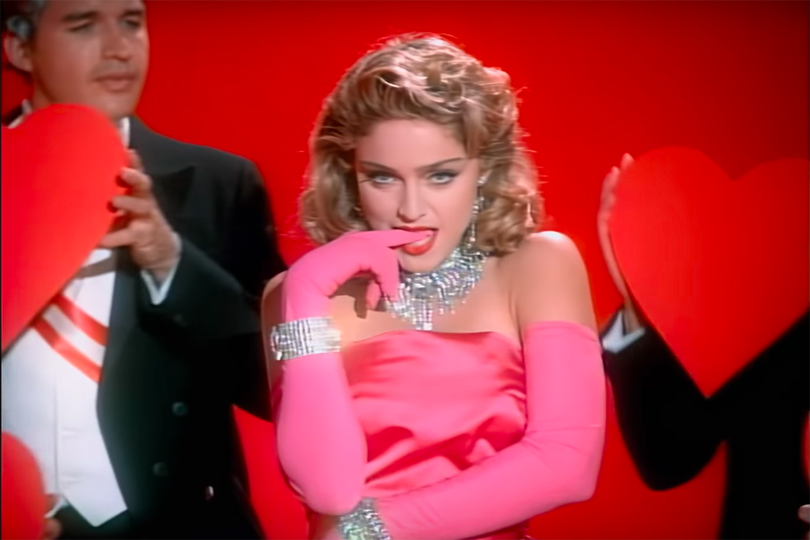
Madonna’s pink Monroe-inspired gown was originally made for the 1980 television movie Norma Jean, and was rented from the Palace Costume and Prop Company just prior to the shoot by stylist and costume designer Marlene Stewart. Like Monroe, Madonna wasn’t wearing diamonds from Tiffany & Co. or Cartier.… Much of the jewellery that Madonna wore in the video was from the collection of Connie Parente, a popular Hollywood jewellery collector.
Madonna reportedly hated wearing the pink dress replica, saying it was incredibly uncomfortable to dance in during the filming of the music video. But, uncomfortable or not, the video helped usher Madonna to superstardom, and earned Madonna her first TV Guide cover, illustrating an article on how to tell good music videos (like “Material Girl”) from bad.
“Material Girl” was just the first time that Madonna would directly pay tribute to Monroe in her career: she would continue to do it, enthusiastically and with success, numerous time over the years. Interestingly, actor Sean Penn (Madonna’s first husband) first met Madonna on the set of this video, and on one of their first dates he took Madonna to visit Monroe’s grave.
As for Travilla’s thoughts on the homage? He approved, telling People magazine in 1985, “To paraphrase Madonna…I’ve been knocked off for the very first time.”
![]()
Want more? You can read other stories from our The Story Of series (like THE STORY OF: Marilyn Monroe’s Signature Blonde Hair and THE STORY OF: Madonna’s Iconic Jean Paul Gaultier Cone Bra) right here.

